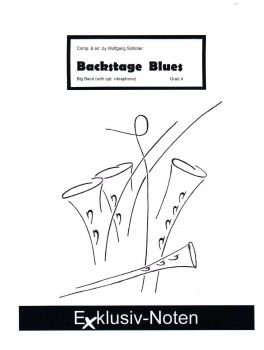Categories
Newsletter

instrumentation & included in delivery
- transposed score
- Saxophones
- Ss1, As2, As1 (replacing ss1)
- Ts1, Ts2
- Bs
- trumpets
- Tp1 (flugelhorn)
- Tp2
- Tp3
- Tp4
- trombones
- Tb1
- Tb2
- Tb3
- Tb4 (bass trombone)
- Rhythm section:
- Guitar
- Piano
- Bass
- drums
- Vibraphone
peak tones:
trumpet 1: e3 (opt. g3)
trombone 1: a1
This composition by Wolfgang Schluter is a 12/8 beat blues. The arrangement has been played by several big bands, among them the NDR Bigband of which Wolfgang was a member for about 30 years until his retirement. Originally this arrangement was a feature for vibraphone with an improvised free solo cadence, a solo and a closing cadence. If no vibraphone is available, the arrangement can also be played as a feature for flugelhorn. However please keep the annotations in the flugelhorn voice in mind. It is also possible to leave out the cadence at the beginning with the pickup of the bass instruments before letter A. If performing with full instrumentation the melody is played by the vibraphone, guitar, flugelhorn and soprano saxophone (or optionally alto). Here particular attention should be paid to good intonation of the winds/brass as well as to the many embellishments. These must be played identically throughout the various instruments if at all possible. In the accompaniment there are many 'interjections' by the other winds and brass (esp. trombones and tenor saxes etc.). The dotted quarter notes need to be played to their full length. Sometimes however there are also short phrase endings (eighths or quarters). Section A should be played in a restrained manner (so that a good blend of the instruments playing the melody can be heard). Section B is orchestrated more fully and is louder. Both sections conclude with a relatively strong trumpet ascension. Trumpets and alto saxophones are melodically in the foreground during section C before the first climax in the fourth measure, from which the solo commences. The background in section D may be played by trumpets with mutes (plunger) with a 'wah' on the first three notes of each phrase. The guitar needs to ammend its playing then accordingly. In section E special attention should be paid to a precise execution of the stops. As of the seventh measure the dotted quarters are once again long (trombones!). Finally the dynamics should follow the pitch (f-ff-f). Six measures before the end the syncoptic rhythm must be played precieslyand in an accentuated manner. In order to support the character of the piece it is quite important that winds/brass, vibraphone and guitar play all figures in a relaxed manner and not before the 'beat'. Sometimes it can even be 'laid back'.
- Besetzung Big Band in Standardbesetzung plus Vibraphon.
- Schwierigkeitsgrad 4
- Rudolph, the Red-Nosed Reindeer
- Saxophone quintet or quartet
s/a-a-a/t-(t)-b
arr. by Bernd Frank...
Read more - I'm Dreaming of a White Christmas
- Saxophone quartet s/aatb
arr. by Bernd Frank
comp. by Irving Berlin...
Read more - I'm Dreaming of a White Christmas
- Saxophone quintet s/a-a-a/t-t-b
arr. by Bernd Frank
comp. by Irving...
Read more - Feliz Navidad
- Saxophone Quartet s/aatb
arr. Undine Engel & Bernd Frank
comp....
Read more - Jingle Bells Samba
- Saxophone quartet s/aatb
comp. by James Lord Pierpont
arr. by Heiko...
Read more









